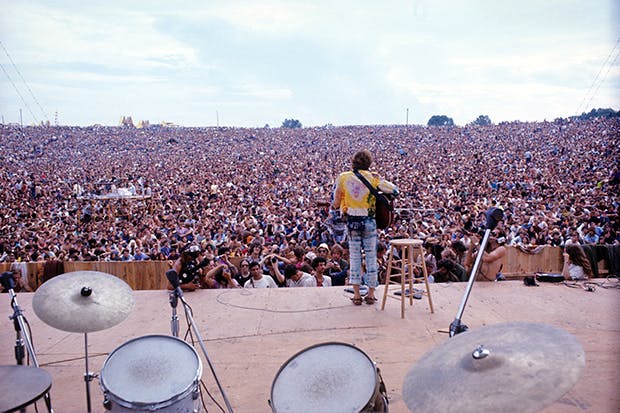Back in the high optimism of the 2008 presidential campaign, one of Barack Obama’s more extravagant hopes was that ‘the psychodrama of the baby boom generation’ would finally be left behind: that no longer would the kind of radical late-Sixties politics ‘hatched on a handful of college campuses long ago’ be seen by both its supporters and its opponents as the key to understanding more or less everything about modern life.
Sadly, though, if Obama needs proof of how comprehensively this hope has been dashed, he need only head to the V&A — where, with the supporters firmly in charge, the whole story of how great the late Sixties were, how much they’ve shaped today’s world, and how much they still could (fingers crossed!) is reverently laid out in the huge exhibition You Say You Want a Revolution? Records and Rebels 1966–1970.
Nobody who visits the show is likely to complain of being short-changed. Apart perhaps from the way most people lived, every aspect of the period is on lavish display: from John Lennon’s Sgt Pepper uniform to American soldiers’ letters home from Vietnam; from a mock-up of Vidal Sassoon’s hair salon to the type-written details of the catering arrangements for Woodstock (apparently there were some). The dozens of films playing include footage of street riots, any number of Swinging London curiosities and an early advert for Barclaycard featuring what can only be called a dollybird in a bikini walking the city streets with her card tucked into her pants and the tagline ‘All a girl needs when she wants to go shopping’.
Yet, while all this works very well — often thrillingly — as a wander through the greatest retro shop in the world, the problem comes with the museum’s dreary determination to turn it, all over again, into a straightforward tale of a repressive establishment meeting the heroic forces of youthful liberation.
Of course, nobody (expect possibly Peter Hitchens) would deny that the late Sixties saw plenty of social progress — and the roots of plenty more. Fifty years on, however, we’re surely ready for a more sophisticated analysis than goodies versus baddies. Is it actually true, for example, that ‘the older, white, well-connected men’ (boo!) who ran the world before 1966 did so entirely for themselves? And, more particularly, what about the exhibition’s supposed goodies? Once again, the Black Panthers are given a far easier ride than they deserve, with the caption on Eldridge Cleaver admiringly mentioning ‘his trajectory from imprisoned criminal to political revolutionary’; but not that his imprisonment was for rape and assault with intent to murder, or that he ended up a Conservative Republican — neither of which fits the exhibition’s narrative. The section on the 1968 Paris riots ends with a mournful note that ‘ironically’ the elections that followed were a triumph for de Gaulle — but why ‘ironically’, rather than, say, ‘consequently’? (And is it too cheap to point out that if the longed-for revolution had taken place, the V&A probably wouldn’t now be mounting such lavish shows?)
The same commitment to received wisdoms is also clear in the section on consumerism. ‘Imagine a generation being able to buy a house their parents could only have dreamt about,’ reads the opening caption — adding that the house could also be furnished cheaply. But, a paragraph later, and for much of the rest of the room, this is duly transformed into a bad thing, with several doom-laden warnings (and some straightforward bellyaching) about the evils of consumerism.
Despite all this, the show is still well worth visiting. For one thing, the exhibits themselves remain hard to beat as a way of plunging yourself into an era that, whatever you think about it, definitely wasn’t boring. For another, it’s always fun to go to an exhibition you can have a good argument with. There are also some genuinely eye-opening moments, particularly in the last room when all that apparent tosh about how Californian communes would alter consciousness and change the world suddenly turns out to be true, given that they were the cradle of the internet. Ultimately, though, the show is at least as revealing about the prejudices of the arts establishment and the intellectual tangle that the left now finds itself in — or, if you prefer, about the psychodrama of the baby boom generation — as it is about the late 1960s.
Meanwhile, back in the present, or maybe the near-future, Somerset House has Björk Digital, starring the world’s most famous Icelander in a series of virtual-reality videos. The actual experience of the show is slightly fiddly. You have to book for a set time and after watching a fairly orthodox pop video in which Björk sings about being cross with a bloke amid a volcanic landscape, you’re led in a group down various corridors from one room to another, pausing in each to put on a VR headset and to see Björk (or parts of her) in front of you in four increasingly strange incarnations.
First is ‘Stonemilker’, where the revolving stool you’re sitting on comes in handy as she pops up singing very close to you at different points in a 360-degree landscape. Next comes a film shot from inside her mouth, followed by one where she has a disturbing amount of facial hair. The big finish is supplied by standing before her as she turns into some sort of giant moth, while promising to protect you from death.
The result spectacularly fulfils its promise to provide an immersive experience — the only possible drawback being that you’re immersed in Björk. As someone who’s always quite liked her in small doses, I found myself nearing my recommended dose by the end, and emerged into the boring old real world more converted to VR than to the woman herself. (And nobody, I suspect, will come out humming the tunes.) Nonetheless, judging from the group I was with, this suitably strange show will certainly delight her fans.
Got something to add? Join the discussion and comment below.
Get 10 issues for just $10
Subscribe to The Spectator Australia today for the next 10 magazine issues, plus full online access, for just $10.














Comments
Don't miss out
Join the conversation with other Spectator Australia readers. Subscribe to leave a comment.
SUBSCRIBEAlready a subscriber? Log in